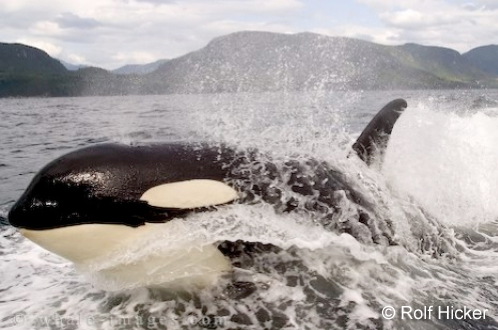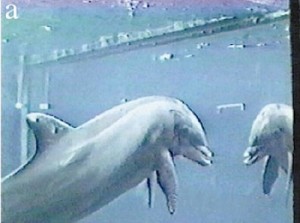Captive Dolphin Research
Should scientists still be using captive dolphins for research?
Dolphins and UsPart One: The Smartest of Us All? “So Long, and Thanks for All the Fish!” Amazing Abilities of Dolphins Dolphins or Humans: Who’s Smarter? Dolphin Society and Culture They’re Super-Brainy, Too More Fascinating Stuff The Great Researcher A Society that Works Are Dolphins “Persons” Life and Culture How Smart is a Dolphin? Experimenting on Dolphins My Visit to the Dolphins Other Links & Videos Mirror Self-Recognition Test The Herman Investigation The Minds of Whales |
Can even the people who do it point to anything valuable they’ve learned from it in recent years? Diana Reiss is a cognitive psychologist and professor at Hunter College and CUNY, the head of marine mammal research at the National Aquarium, and a scientific advisor for the Association of Zoos and Aquariums. In this interview, she defends her work with captive dolphins.
What do we know from your research with captive dolphins that we wouldn’t have known before?
 Diana Reiss: Well, their world in the wild is that they live in very large groups and these groups are made up of smaller sub groups. They have this extraordinary memory, it seems, for remembering who’s who and who they’ve done things with before and this come from years and years of field research in different areas, where you’ve got some animals that stick in groups with mothers and young and you can have multiple generations of animals, grandmothers, mothers, their offspring because learning is really important for these animals. They have to learn from other generations and from each other across generations.
Diana Reiss: Well, their world in the wild is that they live in very large groups and these groups are made up of smaller sub groups. They have this extraordinary memory, it seems, for remembering who’s who and who they’ve done things with before and this come from years and years of field research in different areas, where you’ve got some animals that stick in groups with mothers and young and you can have multiple generations of animals, grandmothers, mothers, their offspring because learning is really important for these animals. They have to learn from other generations and from each other across generations.
And then there are male groups. So we have groups that are sex and age related groups but they mix and mingle as well. So it’s a very complex society. We talk about ape societies and chimpanzee societies as being complex, Machiavellian even, and I think that dolphins are at least that. We really don’t know how complex they are at this point.
And then in aquaria where they’ve had dolphins for many years, you see other aspects that you might not see in the ocean when you are close up and personal.
So, what do you mean by that? What do you learn from captive dolphins?
D.R.: Well, when I was in California, we have a rescue center called the California Marine Mammal Rescue Center, and it’s a wonderful group of people that have been doing this for years. I was a science advisor there and I helped with rescues of a very large whale and dolphins.
The problem is, once you rescue them, then what do you do with them? Because you don’t really want to put a single animal out, if you don’t know if it is going to meet up with the rest of its group. … Some people say we should keep those animals in the aquarium, that those are the animals we should keep in an aquarium, have groups. And many of the rescue facilities are very, very committed to getting those animals out again.
(We later asked if all the dolphins Dr. Reiss works with are animals who needed to be rescued. That is not the case.)
There’s a seaquarium in Florida where they rescue dolphins and have veterinarians work on them. But they also have programs where people get to go swimming with these captive dolphins, and you can see all these kids being brought in and poking the dolphins, and that kind of thing. This place may be doing some good work, but it gets muddled because they promote the rescue stuff as their good works, but at the same time you have this other side of it which is that the whole thing is just a business.
D.R.: Well, there is no easy answer. There are a lot of different situations where dolphins are in captivity. You’ve got rescue facilities that are really needed with trained people, absolutely. You have swim programs [with captive dolphins], which I personally do not support for numerous reasons. We have aquariums that are more themed type aquariums that are more into public entertainment.
That’s your SeaWorld type thing.
D.R.: Well, I think that SeaWorld would be a more themed type aquarium, yes. So most of my work has been done in aquariums, and even those aquariums are mixed.
With dolphins, their entire nature is as a society – their whole culture. So, if you take a dolphin out of that, or even two or three or whatever, and put them in a confined situation, then you’re studying something that fundamentally is not real and is not their real life.
 D.R.: I think we are at the point now that dolphins should not be taken from the wild. Many of the aquariums in the United States have not taken dolphins from the wild for 20 years. Many countries don’t have any dolphins in captivity at all. And what that means is agreements for captive breeding programs, so there are consortiums within the aquarium world that work together, perhaps four or five specific aquariums will work together for that. At the aquarium where I am working – I am a research associate at the National Aquarium in Baltimore – we’ve got ten animals with another on the way. We have a grandmother, her daughter, and her daughter’s offspring, and we have another dolphin that gave birth, and another dolphin has an offspring and another offspring and is expecting another one. So, we’ve got these multiple generations of animals who continue to live together. That to me is maintaining some social integrity.
D.R.: I think we are at the point now that dolphins should not be taken from the wild. Many of the aquariums in the United States have not taken dolphins from the wild for 20 years. Many countries don’t have any dolphins in captivity at all. And what that means is agreements for captive breeding programs, so there are consortiums within the aquarium world that work together, perhaps four or five specific aquariums will work together for that. At the aquarium where I am working – I am a research associate at the National Aquarium in Baltimore – we’ve got ten animals with another on the way. We have a grandmother, her daughter, and her daughter’s offspring, and we have another dolphin that gave birth, and another dolphin has an offspring and another offspring and is expecting another one. So, we’ve got these multiple generations of animals who continue to live together. That to me is maintaining some social integrity.
It’s still a very false existence. What’s the difference, if you are the dolphin, between being taken out of the wild, which you at least still remember, and being born in this situation?
D.R.: I think these are very interesting questions.
Isn’t it an existence that conflicts with your whole nature – your whole DNA?
D.R.: It is hard to answer that question. I don’t know that we have those answers. I think they are interesting questions. I think, on the one hand we are looking at an animal that’s been in an aquarium and it has been with the same animals over the course of the years and then it’s had offspring, I don’t think we know enough about what the world of a dolphin is like to a dolphin to say that. It is something we just don’t know.
You are bringing up questions about should we have animals in captivity at all. Can we learn from them? Is that the point? I think we can learn from dolphins in aquariums. I think you can learn certain things that you just can’t learn in the wild. I think you learn things in the wild, in their natural habitat, that we wouldn’t ever be able learn in aquariums. I think it’s the marriage of that which gives us real insights into what their worlds are about and then gives us a rationale and obligation to fight for them.
What would you say is the kind of thing that we are learning these days from captive dolphins that we did not know before when people were experimenting with them 20 years ago? Are we finding something that is so definitive or new that it justifies having them in captivity?
D.R.: I’m not sure if I can answer them because I don’t know that I know the answers. We know now that these animals have large complex brains from the work that [John] Lilly did [more than 30 years ago] and … that others have done.
 (We asked Dr. Reiss to describe any interesting new things that are being learned from dolphins in captivity. She talked about the famous mirror self-recognition test that took place 10 years ago, about research into language and comprehension that involved dolphins using a keyboard 20 years ago, and about work she did in France roughly 30 years ago. We pressed for anything in the last few years that justifies keeping dolphins in captivity. But even in the one thing she points to in her next answer, she acknowledges that this information is coming from observing dolphins in the wild.)
(We asked Dr. Reiss to describe any interesting new things that are being learned from dolphins in captivity. She talked about the famous mirror self-recognition test that took place 10 years ago, about research into language and comprehension that involved dolphins using a keyboard 20 years ago, and about work she did in France roughly 30 years ago. We pressed for anything in the last few years that justifies keeping dolphins in captivity. But even in the one thing she points to in her next answer, she acknowledges that this information is coming from observing dolphins in the wild.)
D.R.: We’ve seen some really interesting things between generations of animals where we know from the wild and in aquaria that you’ll see females helping out with an offspring. We’ve actually seen some really interesting examples of females that are more experienced mothers actually checking out a mother who is ready to give birth in a way. She may be potentially looking like she might be either testing milk or trying to possibly teach a mother to nurse. We have some data that is really interesting.
Watching young animals develop close up and watching them every day, they feel like my kids when they were born and you watch how they develop each day and what’s going on with their mothers and other members of the group. You get some insights there. I don’t know if you can get that in the wild. Again, these are things we are learning. I’m not saying it justifies X, Y or Z. I’m saying that you’re asking what we’re learning from this.
But by what right? Once you know that apparently dolphins are as self-aware as you’ve proved, when do you say, “OK, this says we should not be dealing with dolphins in captivity in any form?” When is the point when you say that it’s over?
D.R.: I don’t know where that point is.
When would you know?
D.R.: I don’t know. I actually don’t know.
Would you just go on until . . .
D.R.: I don’t know. These are really interesting questions. I would not feel comfortable taking a captive population, from what I know about dolphins now, and putting those animals out in the wild. I don’t know that we’d be doing them a service at this point. The wild is not a panacea. There are natural predators. There are pathogens that these animals are facing out there, some being natural pathogens that the animals face and I heard about lots of pathogens that we as a species have created that have polluted their world. I certainly wouldn’t want to put a group of dolphins that I know personally and care about in the waters around where we are that is polluted. I wouldn’t put my daughter in those waters to swim from some of the things I’ve heard.
We’d all agree that there is no way you can take a dolphin who hasn’t ever even seen the sky or the ocean and put them out there. But when you say “it’s a difficult question,” at some point you have to decide that we are now bringing the whole captive thing to an end, and here’s the plan, we’ve got to round this thing out because it’s over. Within X years, no more breeding, we just phase the thing out. And the fact that we’re polluting the oceans is hardly a reason for keeping animals captive.
D.R.: It’s hard for me to talk about this now because I really don’t know.
